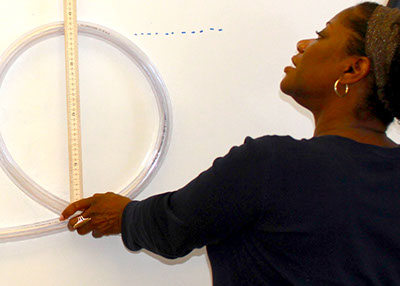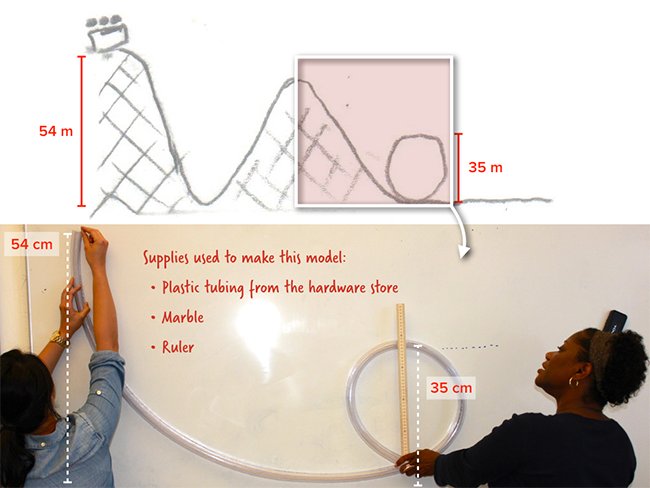SciGen Teacher Dashboard
Unit E1
Potential and Kinetic Energy
Writing: Demo a Marble Run
Duration: Approximately 90 minutes
 This demonstration requires students to apply what they have learned about potential energy, kinetic energy, and momentum. Students are challenged to imagine how they would convince a younger cousin that, if the roller coaster has a loop, a roller coaster with a steep incline and descent is safer than a roller coaster with a shallow incline and descent.
This demonstration requires students to apply what they have learned about potential energy, kinetic energy, and momentum. Students are challenged to imagine how they would convince a younger cousin that, if the roller coaster has a loop, a roller coaster with a steep incline and descent is safer than a roller coaster with a shallow incline and descent.
LEARNING OBJECTIVES
Students apply their use of vocabulary and understanding of potential energy, kinetic energy, and momentum.
Students tailor their language to address a specific audience.
Teacher Tips
- If you have younger students at your school, arrangements can be made to have your students present the lesson to them.
- This roller coaster analogy can be used for more advanced physics concepts as well. For the purposes of Science Generation, we are framing the problem as one of “not making it through the roller coaster ride” so students can link potential and kinetic energy in a way that is engaging to talk and write about. If you have time and interest, you can follow-up with additional fun activities that link potential and kinetic energy.
Materials (optional)
- foam pipe insulation or plastic tubing
- large marble or ball bearing
Teacher Tune-ups
ACTIVITY OVERVIEW
- Pre-writing lesson/discussion (10 minutes)
- Make and test a scale nodel (40 minutes)
- Script a demonstration for younger students (40 minutes)
Pre-writing lesson/discussion (10 minutes)
You’re taking your little cousin to the amusement park for the day, and it’s your job to keep him safe. You really want to go on the roller coaster, and he says he really wants to as well. But you predict that when he sees how tall the roller coaster is at the park, he may back out. He’s always afraid of getting hurt. Thinking ahead, you draw the pictures below for him to make a point that sometimes taller and faster is better.
Think about what you now know about potential energy. Is there more potential energy in the car poised at the top of roller coaster A or in the car at the top of roller coaster B? If you answered A, you’re right! And roller coaster A uses more kinetic energy and momentum to get through the entire ride safely. Though roller coaster B LOOKS less scary, the truth is that it might not have enough energy to get through the loop. Riders might not make it all the way to the end of the ride!

Consider reading the problem situation (on first slide) as a whole class. Then after answering questions about the situation, ask pairs of students discuss solutions. Have students take notes about their discussions.
You may wish to have pairs share out their ideas. After all discussions, ask each student write his or her own response.
: As the text states, a car posed at the top of roller coaster A, which has the steepest inclines and descents, has greater potential energy than a car at the top of roller coaster B. As your students discovered when investigating children swinging, when the cars are at the bottom of each incline, they will have the maximum kinetic energy and no potential energy. When the cars reach the top of the first hill, they again have more potential energy and less kinetic. When the cars reach the bottom of the loop-the-loop, the energy is all kinetic. At the beginning of the loop-the-loop, car A has dropped a greater distance and gone down a steeper incline than car B did, so car A will have greater kinetic energy than car B. Car A will also have a greater momentum than car B, because its velocity is greater. From the drawing, it appears that the kinetic energy for car A will be more than sufficient to carry the car to the top of the loop and around the loop. But the kinetic energy of car B probably won’t be sufficient to carry it to the top of the loop. And for a young cousin hanging upside down, that is a precarious position!
Make and test a scale model (40 minutes)

If you wish, you can have students create a model of the two roller coasters and test their hypothesis. A photograph and list of materials are provided. Foam pipe insulation or plastic tubing is easily bendable and inexpensive, but clear plastic tubing works well also. To keep the pipe steady, it can be taped to a wall or white board. Students can record their findings. Challenge students to determine the minimum height of the “top of the hill” that is needed for the marble to make it through the loop-the-loop.
Script a demonstration for younger students (40 minutes)

It’s your turn to share your knowledge about roller coasters and energy with a classroom of second graders.
Your goal is to make sure the students understand that roller coaster A is safer than roller coaster B and why. How will you explain this in a clear, simple way?
You might want to create a simulation, like the one you made earlier, to make it easier for the kids to grasp the concepts. Or feel free to come up with another fun and effective way to convey your information. Write a script as if you are speaking directly to the students.
Don’t forget to introduce yourself!
BETA Version - Please send comments and corrections to info@serpinstitute.org